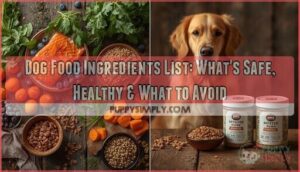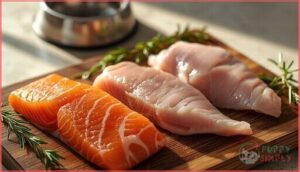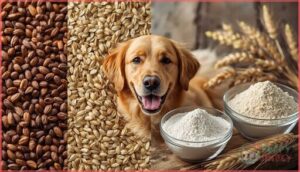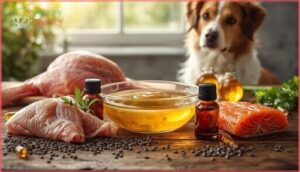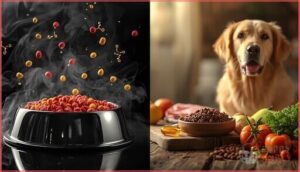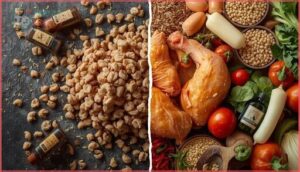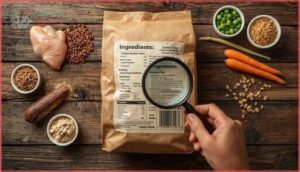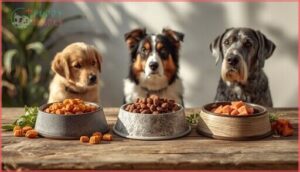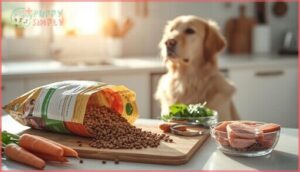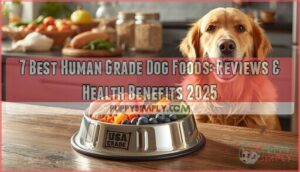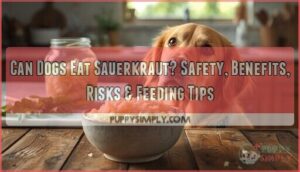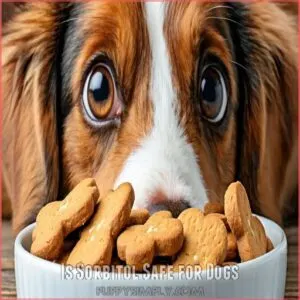This site is supported by our readers. We may earn a commission, at no cost to you, if you purchase through links.
Your dog’s ingredient list reads like a chemistry experiment, but you’re not alone in feeling confused. Most pet owners scan the back of a dog food bag and find terms like “meat meal,” “by-products,” and “chelated minerals” that sound more like lab materials than dinner.
The truth is, what goes into your dog’s bowl directly affects their energy levels, coat quality, digestive health, and long-term wellbeing. Understanding which ingredients support your dog’s nutritional needs—and which ones are just cheap fillers—puts you in control of their diet.
Once you know what to look for, those intimidating labels transform into a clear roadmap for choosing food that keeps your dog thriving.
Table Of Contents
- Key Takeaways
- Key Components in Dog Food Ingredients
- High-Quality Vs. Low-Quality Ingredients
- Decoding Ingredient Lists and Labels
- Special Considerations for Dog Food Ingredients
- Ensuring Safe and Nutritious Dog Food
- Frequently Asked Questions (FAQs)
- What is a good dog food?
- Does pet food have to list ingredients by weight?
- What ingredients are used in dog and cat food?
- What ingredients should a dog eat?
- What is dog food made of?
- How many ingredients are in dog food?
- What are the basic ingredients of dog food?
- What should top 3 ingredients be in dog food?
- What are the best ingredients to put in dog food?
- What is the healthiest food to feed a dog?
- Conclusion
Key Takeaways
- The top ingredients in quality dog food should be named animal proteins, digestible carbohydrates, and healthy fats, all listed by weight.
- Avoid vague meat sources, artificial preservatives like BHA/BHT, and low-nutrient fillers such as corn or soy for better safety and nutrition.
- Whole grains and named animal fats support digestive health, energy, and coat condition, while processed grains and generic fats often lack these benefits.
- Ingredient lists and AAFCO statements help you verify nutritional adequacy, but always check for freshness, expiry dates, and recall alerts to ensure food safety.
Key Components in Dog Food Ingredients
Your dog’s food is more than just kibble in a bowl—it’s a carefully balanced mix of nutrients that keep them healthy from nose to tail. Every ingredient plays a specific role, from building muscle to supporting their immune system.
Let’s break down the key components you’ll find in quality dog food and what each one does for your pup.
Animal-Based Proteins
Your dog’s body runs on amino acids, and real animal muscle proteins—chicken, turkey, beef, fish—deliver them best. Meat meals like chicken meal or salmon meal pack even more protein per ounce than fresh meat because they’re concentrated. Fish oils bring omega-3s for a shiny coat. Even animal byproducts (liver, heart) offer nutrients, though quality varies. Look for named poultry or meat meal on labels.
Ensuring the accuracy of nutritional information is vital, which is why researchers rely on scientific study summaries to make informed decisions.
Plant-Based Proteins
Plant protein ingredients—soy, peas, lentils, chickpeas, fava beans—can supply all essential amino acids when formulas blend them properly. Legume sources like pea isolates work well in modern dog food nutrition, though some plant proteins need methionine or lysine boosted to match animal standards.
Processing temperature and moisture improve digestibility. Your dog’s diet can include these ingredients safely when manufacturers balance them correctly.
Carbohydrates and Grains
Beyond protein, your dog’s nutrition relies on carbohydrates—corn, wheat, rice, barley, and oats—that generally make up 30–70% of commercial dog food ingredients.
Whole grains deliver fiber content, B vitamins, and minerals that support digestion and steady energy.
While some dogs show grain sensitivities, most digest these carbohydrate sources well when manufacturers use quality starch types in balanced formulations.
Fats and Oils
Fats and oils bring more than flavor—they pack 9 kcal per gram, double what carbohydrates deliver, making energy density a key factor in your dog’s nutrition. Named fat sources like chicken fat or salmon oil signal quality and provide essential fatty acids, including linoleic acid and omega-3s.
Balancing omega balance promotes skin, coat, and joint health, though excessive fats can trigger digestive upset in sensitive dogs.
Fiber Sources
Fiber sources do more than bulk up stool—they shape gut health through soluble and insoluble contributions. Prebiotic effects from ingredients like chicory root or beet pulp nourish beneficial bacteria, improving digestion and stool consistency.
Your dog’s dietary needs vary by life stage, so balancing fiber benefits in pet nutrition ensures regularity without sacrificing palatability or energy density in dog food formulation.
Essential Vitamins and Minerals
Micronutrients are essential for your dog’s overall health, supporting immune defenses, vision, and skeletal integrity. Each vitamin and mineral plays a distinct role in canine nutrition, ensuring your pet thrives. Vitamin requirements and mineral balance are crucial to prevent nutrient deficiencies that can compromise your dog’s well-being. For dogs on homemade or specialty diets, dietary supplements may be necessary to fill any nutritional gaps.
| Micronutrient | Primary Function |
|---|---|
| Vitamin A | Vision, immune function, cell growth |
| Vitamin D | Calcium balance, bone health |
| Calcium & Phosphorus | Skeletal structure, metabolic processes |
| B Vitamins | Energy metabolism, neurological support |
Complete dog food formulations are designed to meet these nutrient requirements without the risk of over-supplementation, which can lead to toxicity. Understanding your dog’s dietary needs empowers you to evaluate dog food formulations confidently, ensuring your pet receives the best possible nutrition.
High-Quality Vs. Low-Quality Ingredients
Not all ingredients listed on a dog food label offer the same nutritional value or safety profile. You’ll find stark differences between premium, whole-food sources and low-quality fillers that pad out formulas without supporting your dog’s health.
Understanding what separates high-quality ingredients from inferior ones helps you choose food that truly nourishes rather than just fills the bowl.
Identifying Premium Protein Sources
Premium protein starts with named animal sources—chicken, turkey, or salmon—rather than vague “meat” terms. You’ll want high digestibility and single-source options like real duck to reduce allergen risks. Fish oil–rich proteins deliver omega-3s for coat and joint health, while quality meat meals concentrate amino acids without fillers. Check for transparent sourcing and third-party certifications to verify claims beyond marketing language.
| Premium Protein Indicators | Red Flags in Ingredients |
|---|---|
| Named animal sources (chicken, salmon) | Ambiguous “meat” or “animal digest” |
| Traceable sourcing with certifications | Unspecified by-products |
| High digestibility metrics | Excessive protein concentrates without source ID |
Recognizing Whole Vs. Processed Grains
Whole grains retain all three kernel parts—bran, germ, and endosperm—delivering fiber content, vitamins, and steady energy release for digestive health. Processed grains, on the other hand, pose risks such as stripped bran, faster blood sugar spikes, and reduced micronutrients. When selecting dog food, look for ingredients like “whole barley” or “brown rice,” as these cereals provide carbohydrates with intact grain nutrition and offer the whole grain benefits your dog’s system needs.
| Whole Grain Indicators | Processed Grain Signals | Health Impact |
|---|---|---|
| “Whole” prefix on label | “Rice flour,” “corn starch” | Fiber aids gut motility |
| Brown rice, whole barley | Enriched or refined grains | Steadier energy vs. spikes |
| Chewier texture in kibble | Faster digestibility rates | Better satiety, weight control |
Benefits of Named Animal Fats
Fat source transparency matters when you’re reading dog food labels—named animal fats like “chicken fat” or “beef tallow” offer traceable sourcing and defined fatty acid balance, supporting skin health and energy delivery. Unlike generic “animal fat,” these ingredients provide nutrient bioavailability you can verify, ensuring your dog receives essential omega-3 and omega-6 ratios for ideal coat condition and digestive function.
| Named Fat Advantage | Transparency Benefit |
|---|---|
| Chicken fat, salmon oil | Verifiable origin and quality |
| Defined fatty acid profile | Aids omega balance evaluation |
| Reduced unnamed byproducts | Enhances ingredient accountability |
Risks of Artificial Additives and Preservatives
Synthetic additives may seem harmless on ingredient lists, but artificial preservatives like BHA and BHT carry carcinogenic risks in some animal studies, and certain colorings trigger food allergens in sensitive dogs. Long-term exposure can disrupt gut health, so regulatory compliance alone doesn’t guarantee food safety—you’ll want to prioritize natural alternatives when evaluating pet food ingredients and additives for your dog’s well-being.
Artificial preservatives like BHA and BHT pose carcinogenic risks, so prioritize natural alternatives over regulatory compliance alone when choosing dog food
| Additive Type | Potential Risk | Safer Alternative |
|---|---|---|
| BHA, BHT | Carcinogenic concerns | Mixed tocopherols (vitamin E) |
| Artificial colorants | Allergic reactions, intolerances | No added dyes |
| Synthetic flavor enhancers | Gut microbiome disruption | Natural meat flavors |
Common Low-Quality Fillers to Avoid
Ingredient labels often hide meat byproducts, unidentified poultry byproducts, and rendered products that lack nutritional punch. Filler ingredients like corn, wheat, or soy bulk up kibble without real benefits, while artificial preservatives such as BHA, BHT, ethoxyquin, and propyl gallate introduce toxic substances over time. Meat meal without a named source signals low-quality additives you’ll want to skip entirely.
| Filler Type | Why It’s Low Quality | What to Look For Instead |
|---|---|---|
| Generic meat meal | Undefined animal sources | Named protein (chicken meal, beef meal) |
| Corn, wheat, soy | Minimal nutrition, allergen risk | Whole grains or vegetables |
| BHA, BHT, ethoxyquin | Linked to organ toxicity | Natural preservatives (tocopherols) |
Decoding Ingredient Lists and Labels
Reading a dog food label isn’t as straightforward as it looks—manufacturers follow strict formatting rules, but they also use clever tactics to make products appear more appealing than they might be.
You need to know what those ingredient names really mean and how the order reveals what’s actually in the bag.
Let’s break down the key elements you’ll encounter so you can separate marketing spin from nutritional facts.
Ingredient Order and Weight Significance
You’ll notice that dog food ingredients appear in descending order by weight—heaviest first, lightest last. Here’s what ingredient ranking reveals:
- Fresh meat (chicken, beef) contains 60–75% water, inflating its position before processing effects remove moisture.
- Meat meals list lower but deliver concentrated protein after water content is removed.
- Grains and flours reflect their dry mass more accurately due to low moisture.
- Processing effects shift final nutritional proportions beyond what ingredient labeling shows.
- Food labeling regulations (FDA/AAFCO) require listing by pre-cooking weight, not nutritional contribution.
Water content skews rankings—fresh chicken listed first may contribute less usable protein than chicken meal appearing later.
Understanding Major and Minor Ingredients
Now that you understand ingredient order by weight, you need to distinguish major from minor components in dog food ingredients. Major ingredients—your primary protein sources and carbohydrates—appear at the top and constitute the bulk of the formula. Minor additives follow: vitamins, minerals, flavor enhancers, and preservatives that round out nutrient profiles without adding significant weight. Ingredient labeling reflects approximate processing weight, so ingredient identification requires looking beyond position alone.
Food safety standards require disclosure of all food ingredients, helping you verify that supplements and fortifiers support—not replace—core nutrition.
| Category | Examples | Purpose |
|---|---|---|
| Major Ingredients | Chicken, pork meal, rice | Protein and energy base |
| Minor Additives | Vitamin A, calcium, inulin | Nutritional completeness |
| Trace Components | Natural flavors, colorants | Palatability and texture |
Regulatory Labeling Standards
Label compliance and ingredient disclosure aren’t optional—they’re backed by AAFCO and the FDA. Regulatory enforcement in pet food requires manufacturers to list every component by weight and include a nutrition label confirming the formula meets established standards.
Food safety and labeling laws prevent misleading claims, so you can trust that regulatory compliance in pet food protects your dog from mislabeled or incomplete diets.
Meat Vs. Meat Meal on Labels
You’ve probably noticed “meat” and “meat meal” on dog food ingredients lists and wondered which one’s better. Here’s what separates them:
- Meat includes natural moisture and animal flesh, while meat meal is a concentrated powder created through the rendering process that removes water.
- Meat meal delivers higher protein sources per pound due to nutrient density from rendering.
- Label transparency matters—”chicken” beats vague “poultry meal” every time.
- Compare actual grams of protein rather than trusting the term alone.
Marketing Terms and Misleading Claims
You’ll see “natural,” “grain free,” or “human grade” splashed across pet food labels—but label regulations don’t always require proof behind these claims. Terms like “superfoods” sound impressive yet rarely improve your dog’s nutrition.
Some grain free diets substitute questionable ingredients, and preservatives labeled “natural” aren’t necessarily safer.
Focus on actual ingredients lists rather than marketing buzzwords when evaluating pet food and nutrition.
Special Considerations for Dog Food Ingredients
Not every dog thrives on the same ingredients, and life stage, breed, or individual sensitivities can change what your dog needs in their bowl.
Puppies require different nutrient ratios than seniors, certain breeds face unique dietary challenges, and dogs with allergies or intolerances need careful ingredient selection.
Here’s what to keep in mind when your dog’s needs go beyond standard formulations.
Puppy and Senior Formulation Differences
Your puppy’s body demands far more than your senior dog’s—and that’s why Life Stage Nutrition matters. Puppies need higher protein and energy requirements to fuel rapid growth, while seniors benefit from joint health nutrients and easily digestible ingredients. As digestive needs shift with age, so do nutrient ratios.
- Puppies require elevated calorie density and calcium-to-phosphorus balance for bone development
- Senior formulas reduce calories to prevent obesity while supporting aging organs
- Dietary needs and requirements evolve—choose dog food ingredients customized to pet nutrition and diet at each stage.
Breed-Specific Ingredient Needs
Not all breeds thrive on the same formula—your dog’s size, genetics, and metabolism shape their dietary requirements. Small breed dogs need nutrient-dense protein sources for faster metabolisms, while large breed formulas demand balanced mineral balance to support joint health.
Breed-specific diets address unique fat requirements, carbohydrate needs, and breed nutrition profiles, ensuring your dog receives ideal breed specific nutrition adapted to their biological blueprint.
Ingredients for Sensitive Stomachs and Allergies
When your dog struggles with food allergies or a sensitive stomach, selecting the right ingredients becomes critical for their digestive health. Novel proteins like venison or duck minimize reactions, while hydrolyzed protein diets break down components for easier absorption.
For ideal pet nutrition and hypoallergenic diets, prioritize:
- Single animal protein sources with explicit naming (e.g., chicken meal vs. unnamed “meat meal”)
- Natural preservatives (vitamin E, rosemary extract) over synthetic BHA/BHT that irritate sensitive stomachs
- Gentle carbohydrates such as oats or rice, avoiding corn and wheat in dog food nutrition formulations
Grain-Free and Limited Ingredient Diets
Grain-Free Options swap wheat and corn for potatoes or peas, while Limited Ingredient Diets simplify your dog’s menu to one Novel Protein and minimal carbs. These formulas target Digestive Health in dogs with suspected sensitivities, though true grain allergies remain rare.
| Diet Type | Primary Benefit |
|---|---|
| Grain-Free | Eliminates gluten-containing cereals |
| Limited Ingredient Diets | Reduces potential allergens |
| Novel Proteins (venison, duck) | Minimizes exposure to common triggers |
| Hydrolyzed formulas | Aids sensitive stomachs |
| AAFCO-compliant recipes | Ensures Nutrient Balance despite restrictions |
Always shift gradually over 7–14 days and consult your vet before switching—some Grain-Free Dog Food formulations have raised cardiac concerns in susceptible breeds, making veterinary oversight essential for long-term Protein adequacy and safety.
Ensuring Safe and Nutritious Dog Food
Choosing the right ingredients is only half the battle—you also need to make sure the food you buy is actually safe and nutritionally complete. Understanding how to verify quality, store food properly, and stay informed about potential issues protects your dog from preventable health risks.
Here’s what you need to know to keep your dog’s diet both safe and nourishing.
AAFCO Nutritional Adequacy Statements
AAFCO statements provide the roadmap to nutritional adequacy, confirming your dog’s food meets regulatory updates and pet nutrition standards. You’ll find these label compliance notes on every quality product, indicating whether it passed feeding trials or matched nutrient profiles for specific life stages.
Understanding pet food labels means checking the dietary requirements for dogs against these benchmarks—they’re your shortcut to evaluating ingredients and nutritional content of pet food.
Proper Storage and Handling of Ingredients
Once you’ve confirmed nutritional adequacy, preserving ingredient freshness becomes your next priority. Store dry kibble in airtight storage containers in a cool, dry spot—direct sunlight accelerates fat oxidation, compromising food safety and quality.
Refrigerate opened cans immediately, and maintain pest control methods to protect against contamination. Label everything with purchase dates for effective shelf life management, ensuring your quality control measures align with food manufacturing regulations.
Identifying Freshness and Expiry
Beyond proper food storage practices, you’ll need practical ways to verify packaging safety and confirm your dog food hasn’t crossed its shelf life threshold. Check for “Best by” dates on every bag—these indicate peak freshness, not absolute expiry, but they guide smart rotation.
Trust your senses with freshness tests:
- Look for oil separation, mold, or color changes
- Smell for rancid odors indicating fat oxidation
- Feel texture changes from moisture exposure
- Monitor temperature abuse during shipping or storage
Preservatives extend shelf life, but proper handling remains your pet health safeguard.
Monitoring for Recalls and Safety Alerts
Even fresh, properly stored dog food can become unsafe if recall alerts go unnoticed. Sign up for FDA Guidelines updates and Pet Food Regulation notices to receive safety notices immediately.
Check the Center for Veterinary Medicine database regularly, verify lot numbers on your dog food packaging, and report concerns to veterinary care providers.
Consumer protection depends on your active monitoring—recalls address contamination, preservatives issues, and other pet health risks requiring swift action.
Frequently Asked Questions (FAQs)
What is a good dog food?
Finding a “pawsitively” complete food means you’ll look for named animal protein sources, balanced nutrients meeting AAFCO standards, healthy fats, digestible carbohydrates, essential vitamins and minerals—and zero artificial additives or fillers.
Does pet food have to list ingredients by weight?
Yes, regulatory compliance requires pet food manufacturers to list ingredients by weight in descending order. This weight disclosure and ingredient ordering standard ensures label transparency, helping you identify primary food ingredients and evaluate food safety standards.
What ingredients are used in dog and cat food?
The simplest ingredients can spark the most complex debates. Pet food blends animal proteins—chicken, beef, fish—with grains, legumes, fats, and fortified vitamins to meet your dog’s nutrient profiles and dietary trends.
What ingredients should a dog eat?
Your dog needs high-quality protein sources, healthy fats with omega fatty acids, digestible carbohydrates, essential vitamins and minerals, and proper nutrient balance customized to their life stage and activity level.
What is dog food made of?
Commercial dog food contains protein sources (meat, poultry, fish), carbohydrates (grains, starches), fats (animal or plant oils), fiber, vitamins, and minerals.
Ingredient quality and nutrient balance determine your dog’s overall pet nutrition and health.
How many ingredients are in dog food?
Like clockwork, most dog food formulas contain 6 to 15 ingredients on their labels, though specialized diets may list over 20 when vitamins, minerals, and functional additives support complete nutrient balance.
What are the basic ingredients of dog food?
Your dog’s bowl holds protein sources like chicken or fish, carbohydrate types such as rice, fats for energy, plus essential vitamins and minerals that keep organs functioning properly every single day.
What should top 3 ingredients be in dog food?
Your dog’s bowl should hold treasures worth examining. Look for high-quality animal protein first, followed by a digestible carbohydrate source, then healthy fats—this trio ensures ideal nutrient balance and bolsters your dog’s vitality.
What are the best ingredients to put in dog food?
Premium protein sources like deboned chicken or salmon meal, whole grains such as oats, named healthy fats including fish oil, plus balanced vitamins and minerals create an ideal nutrient balance while supporting your dog’s overall health.
What is the healthiest food to feed a dog?
Your best bet for canine health isn’t a magic bullet—it’s a complete, AAFCO-approved diet with high-quality animal protein, balanced fats, digestible carbohydrates, and essential vitamins that match your dog’s life stage.
Conclusion
Knowledge is power regarding your dog’s health. A well-informed approach to reading a dog food ingredients list ensures your pet receives ideal nutrition, avoids harmful additives, and maintains long-term vitality.
You now possess the tools to distinguish quality proteins from fillers, recognize misleading marketing claims, and select formulations customized to your dog’s specific needs.
Your diligence in scrutinizing ingredients translates directly into years of improved health, energy, and quality of life for your companion.

